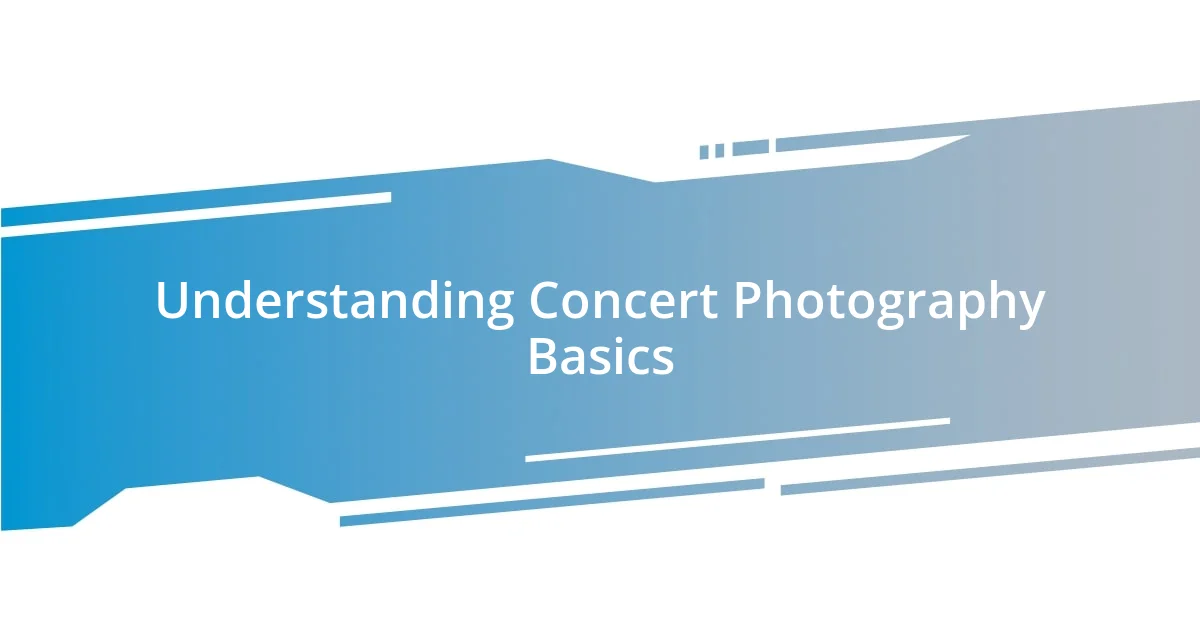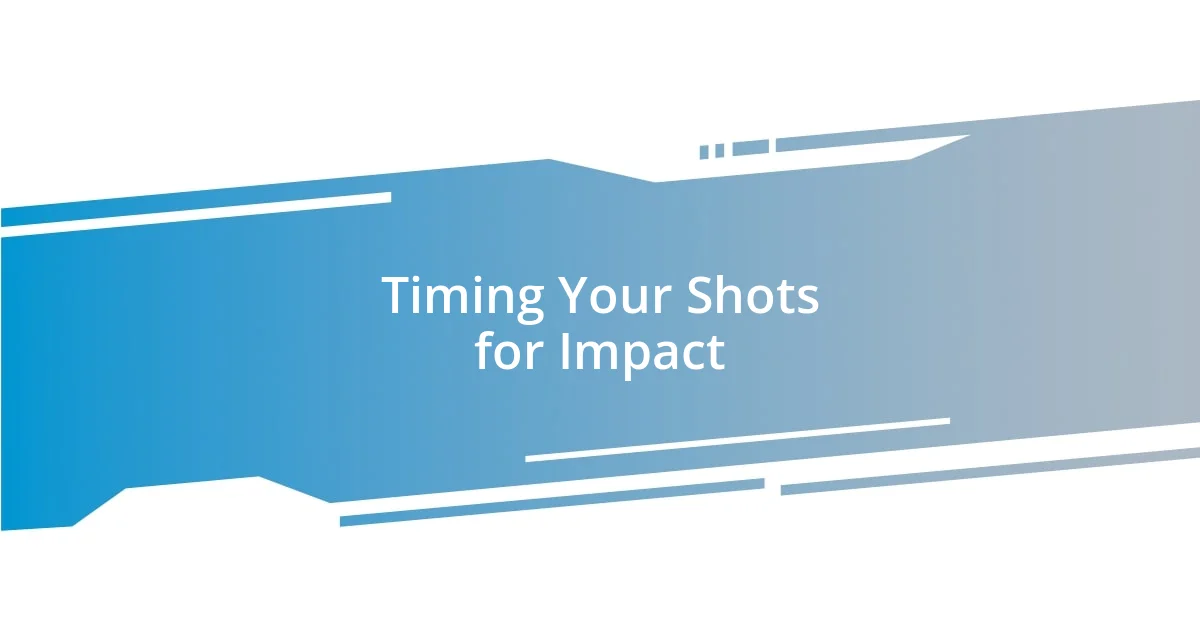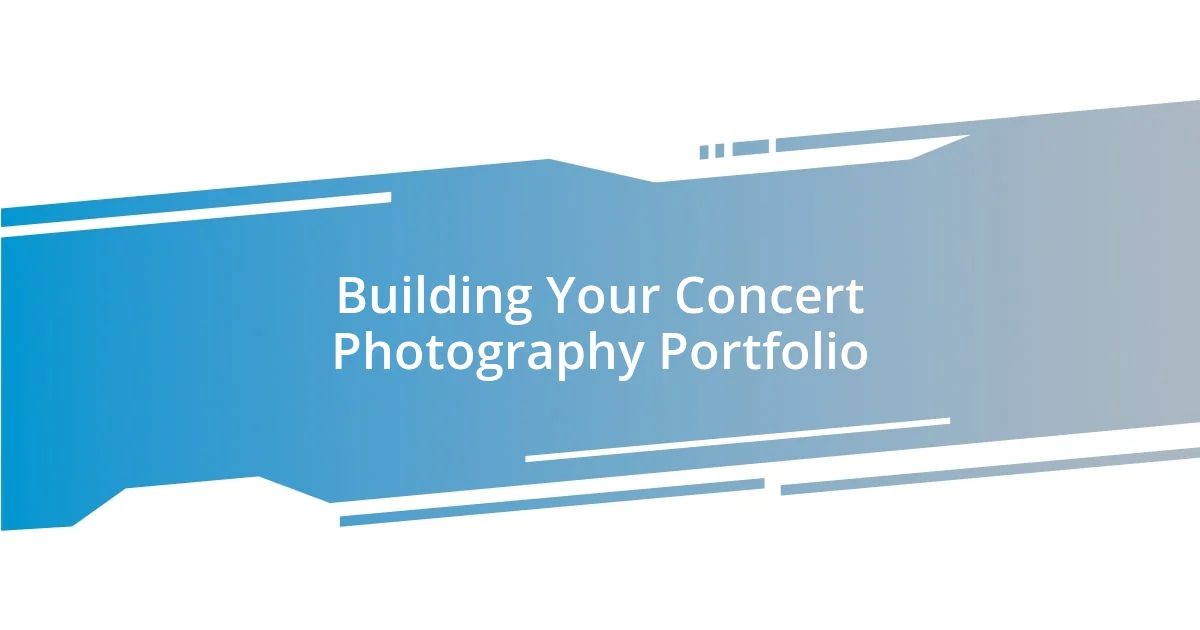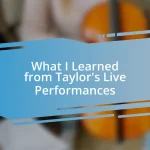Key takeaways:
- Understand the importance of lighting, equipment, and camera settings for effective concert photography, including the need for low-light capabilities and fast shutter speeds.
- Utilize techniques like continuous shooting and awareness of surroundings to capture dynamic moments and unique angles that enhance the story of the performance.
- Post-processing is crucial for enhancing images, with a focus on color vibrancy, cropping for emotional impact, and maintaining a cohesive style across your portfolio.

Understanding Concert Photography Basics
Concert photography is truly a unique blend of art and chaos. I remember the first time I stepped into a crowded venue, my heart raced with excitement and fear. How do you capture the energy of a live performance in a single frame? It’s all about understanding the dynamics of the environment.
Lighting plays a huge role in concert photography, often shifting dramatically throughout the show. I vividly recall a moment when I was shooting a band under intense, colored lights. The challenge of balancing my exposure settings while trying to catch that perfect moment was exhilarating. It taught me the importance of experimenting with your camera settings to adapt quickly to changing conditions—isn’t it fascinating how much learning happens in those fleeting seconds?
Another key aspect to grasp is the relationship between the photographer and the performers. I once found myself on stage, completely immersed in the music, and for a split second, the artist looked my way. It was as if time froze, and I knew then that capturing the authenticity of that moment was my top priority. Remember, it’s about creating a connection; the more genuine your shots, the more they resonate with viewers.

Essential Gear for Concert Photography
When it comes to concert photography, having the right gear can make all the difference. I’ve learned through experience that your equipment is not just a tool; it’s an extension of your vision. I remember one show where I mistakenly left my preferred lens at home—what a disaster! Capturing that dynamic energy from the back of the venue just didn’t feel the same, and I missed out on some incredible shots. Investing in versatile, high-quality gear ensures you’re always ready to capture those unforgettable moments, even when the unexpected happens.
Essential Gear List:
- Camera Body: A DSLR or mirrorless camera with good low-light performance.
- Lenses: A fast lens, like a 50mm f/1.8 or a zoom lens like 24-70mm f/2.8, to handle various shot types.
- Memory Cards: High-capacity and fast-speed cards to prevent missing crucial shots.
- Tripod or Monopod: Useful for stability, especially in longer shows.
- Backup Batteries: Concerts can be long, and you don’t want to risk running out of power.
- Ear Protection: Protect your hearing while you shoot, especially near loud speakers.
This gear setup has served me well, providing both versatility and quality. I can’t stress enough how essential it is to be prepared. The right equipment not only enhances your ability but also gives you peace of mind, letting you focus on the music and the moment.

Best Camera Settings for Concerts
When it comes to capturing concerts, finding the right camera settings is critical. From my experience, I often start with an aperture of around f/2.8 or wider—this allows more light in, which is essential in low-light environments. I still remember a night filled with vibrant visuals where my f-stop choice enabled those crisp, beautiful images even in the dusky setting of a smaller venue.
Shutter speed is another key player. I generally set mine between 1/200 to 1/500 of a second to freeze the action, but I also have to be mindful of the artist’s movements. There was a moment during a high-energy performance when I needed to quickly adjust my shutter settings to capture a dancer’s leap mid-air; it turned out to be one of the shots that perfectly encapsulated the concert’s spirit!
ISO settings are equally crucial; I typically find myself increasing the ISO to around 1600-3200. This elevates the camera’s sensitivity to light without sacrificing too much detail. I remember blending different ISO levels during a show, discovering that sometimes you need to balance noise and clarity for the best result. It’s always a challenge, but part of the thrill lies in mastering your camera settings while embracing the unpredictable nature of live music.
| Setting | Recommended Value |
|---|---|
| Aperture | f/2.8 or wider |
| Shutter Speed | 1/200 to 1/500 sec |
| ISO | 1600-3200 |

Techniques for Capturing Great Shots
Capturing great shots at concerts goes beyond just technical settings; it’s about anticipating the moment. One technique that really works for me is to stay attentive to the artists’ expressions and movements. I remember being in the pit at one show when the lead guitarist leaned into the crowd, and I instinctively raised my camera just in time to catch that electrifying connection. Isn’t it exhilarating when you can capture that sheer excitement as it unfolds right in front of you?
Another valuable approach is to utilize continuous shooting mode. I often activate this feature to capture a series of images in rapid succession, especially during high-energy moments. There was one concert where the drummer’s furious beats created a spectacle of motion—by clicking away in bursts, I ended up with a striking sequence that told the story of the music’s intensity. Have you ever tried this? It can be a game-changer, allowing you to select the perfect frame later.
Lastly, I can’t emphasize enough the importance of being aware of your surroundings. Try to find unique angles or vantage points that can elevate a standard shot into something magnificent. One night, I noticed a mirror ball reflecting colored lights around the venue and quickly repositioned myself. The resulting images were a kaleidoscope of vibrant colors that truly captured the atmosphere of the event. Isn’t that what we aim for—images that evoke the emotion of the moment long after the last note has been played?

Timing Your Shots for Impact
Timing your shots can truly make or break your concert photography, and it’s something I’ve honed through experience. The heartbeat of a performance comes alive in those fleeting moments—the guitarist just before a solo, or the moment a singer connects with the audience. I’ve found that counting the rhythm of the music helps; once you get a feel for the tempo, it’s almost like second nature to anticipate the perfect shot.
There’s an adrenaline rush when you align your photography with the music’s peak. I remember a particular concert where the lights dimmed, and the crowd held its breath right before a song dropped. I could feel the excitement in the air, and as the beat exploded, I pressed the shutter just in time to capture the artist’s ecstatic expression. It’s those split-second reactions that elevate your work to new heights. Have you ever felt that pulse and managed to freeze it in time?
And let’s not forget the importance of variety in your shots. Timing isn’t just about the iconic moments. I always strive to mix wide shots with close-ups, capturing the energy of the crowd alongside the artist’s intense focus. At one show, while capturing the drummer, I caught a glimpse of the audience’s response—a surge of hands in the air, lost in the euphoria of the moment. The blend of both perspectives told a richer story about the performance. Isn’t it fascinating how timing can tell a narrative in a single frame?

Post-Processing Tips for Concert Photos
Post-processing concert photos is where the magic truly begins. When I sit down to edit, I often start with adjusting exposure and contrast to bring out the vibrancy of the colors that may have been washed out by stage lights. For instance, I remember a particular gig where the purple lights mixed with smoke created a dramatic ambiance. Initially, the shots felt flat, but with a little adjustment in Lightroom, those images transformed into a striking portrayal of the band’s raw energy. Isn’t it remarkable how a simple tweak can bring a whole new life to your work?
I also love to play with cropping during post-processing. Sometimes, a tightly cropped image can focus attention on an artist’s expression or an electric moment that might be lost in a wider shot. I recall a time at an outdoor festival when I captured a singer caught in a moment of euphoria, but the surrounding clutter distracted from it. After cropping, the essence of the artist’s joy was crystal clear, turning the photo into an emotional connection. Have you experienced the power of cropping? It’s like sculpting the image to highlight what truly matters.
Finally, I firmly believe in the importance of consistency across your portfolio. I often spend time developing a unique editing style that reflects not just the concert atmosphere but also my artistic voice. A few months back, while editing a series from different shows, I noticed that varying my editing techniques diluted the overall impact. So, I started to apply a cohesive color grading approach, which helped to unify the feel of my concert series. Isn’t it satisfying when your body of work tells a cohesive story, reflecting the authenticity of your eye?

Building Your Concert Photography Portfolio
Building your concert photography portfolio is an exciting journey that showcases not just your best work, but also the breadth of your unique style. I often look back at my initial portfolio and realize how pivotal it was to document different genres and settings. Each concert, whether an intimate acoustic set or a high-energy rock show, taught me something new about lighting, composition, and capturing emotion. Have you ever considered how the diversity in your portfolio speaks to your adaptability as a photographer?
A critical aspect for me has been the inclusion of behind-the-scenes shots and moments that offer a glimpse of the experience, not just the performance. For example, during a local band’s gig, I captured the lead guitarist tuning his guitar, lost in thought—this candid moment added depth to my collection. It created a narrative beyond the stage, inviting viewers to feel part of the whole atmosphere. How often do you think about the stories that lie outside the spotlight?
Lastly, I never shy away from sharing my work on social media and to various platforms. Engagement has been integral for me in building an audience. I remember sharing my concert images from a music festival, and the positive feedback motivated me to further refine my craft. The comments and shares not only boosted my confidence but helped me connect with other photographers and artists alike. How do you leverage social platforms to showcase your voice in the photography community?












